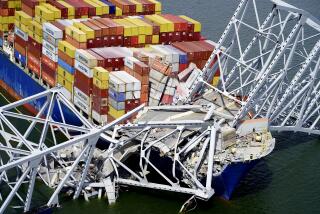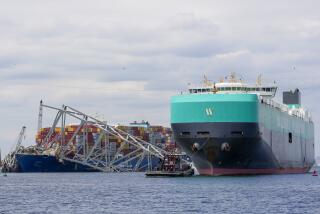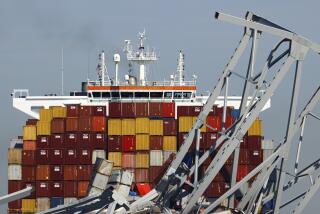Archeologists Hunting for the Lion of Baltimore
- Share via
ANNAPOLIS, Md — ANNAPOLIS, Md. -- While British troops were attacking Washington on Aug. 24, 1814, a minor skirmish in the War of 1812 was taking place at Bodkin Point near the mouth of the Patapsco River south of Baltimore.
Writing in his journal, a British Royal Marine lieutenant recorded that the HMS Menelaus, captained by Sir Peter Parker, had burned “a fine schooner named the Lion of Baltimore.”
Now archeologists are pursuing tantalizing clues that the remains of the Lion, believed to be between 85 and 100 feet long, may lie under the muddy waters of Bodkin Creek. Finding remnants of the burned schooner would provide evidence of a previously undocumented event in the military history of the young American nation. State archeologists used sonar last fall to pinpoint the location of what may be a ship’s hull.
“We were led to the area by several boaters who kept running into something on very shallow tides,” said Steven Bilicki, an archeologist with the Maryland Historical Trust. “We started to see something very strange. We got to go down on the site about 20 minutes and there was wood on the bottom.”
But the dive was cut short because of weather, and “we were restricted from diving the rest of the year because of weather conditions,” he said.
“We’re going to get back there at some point this year, at least to probe with hand probes,” Bilicki said, adding that the dive could be made in July or August. He would also like to use a magnetometer, which would pick up signals from cannon and other metal in a ship’s hull.
Several other potential sites in the 700-square-acre Bodkin Creek watershed, which has three branches ranging from about a mile to 2 1/2 miles long, also could be explored as the hunt for the Lion takes shape.
Kim Nielsen, director of the U.S. Navy Museum in Washington, said the potential discovery of the Lion comes at a fortunate time with the nation beginning preparations for the celebration of the bicentennial of the War of 1812. As part of the celebration, the National Park Service is working to establish a Star-Spangled Banner National Historical Trail that will include sites where British and American troops battled.
Nielsen said proof that a skirmish took place in Bodkin Creek could place added importance on Hancock’s Resolution, a small farmhouse preserved as part of the Anne Arundel County park system. The house was patented in 1793 under the name Hancock’s Resolution by Stephen Hancock Jr. The name is believed to refer to resolution of a boundary dispute. There is evidence, although no proof, that Hancock’s Resolution was used as a signaling station during the war, and Nielsen would like to see it included on the trail along with the Bodkin Creek site of the sinking of the Lion.
“Militias had set up a system ... to signal back and forth across the bay and up and down the bay which way the British ships were going,” said Jim Morrison, founder and president of Friends of Hancock’s Resolution, set up to preserve the house. “The family story was that Hancock’s Resolution was a part of that signaling system.”
Hancock’s Resolution fronts on Bodkin Creek near where the Lion is believed to have been sunk by the Menelaus, a 36-gun frigate used by the British to blockade the port of Baltimore.
Nielsen, who works in Washington but lives in Anne Arundel County, became involved with Hancock’s Resolution at a time when the Naval Historical Center was publishing the third volume in a history of the War of 1812 that dealt with the Chesapeake Bay campaign.
Included in that volume, Nielsen said, was a letter from Parker to his superior on Tangier Island, Va. It referred to naval activity on Narrows Creek, an earlier name for Bodkin Creek.
“The Enemy have several Gun Boats at Baltimore which have been twice driven in by His Majestys Ship, and on the 24th inst. Lieut. Warre with two Boats burnt a Schooner in Narrows creek close to Bodkin point in face of these Gun Vessels,” Parker wrote.
In Parker’s dispatch, he let his superiors know: “Things are going well, I’m blockading Baltimore and, by the way, we burned a schooner in Bodkin Creek.”
Nielsen found another piece of the puzzle through an Internet search last fall. It was the journal kept by Royal Marine Lt. George Beynon, who served under Parker. Beynon’s account of the skirmish confirmed the date, the burning of an American ship and provided yet another clue -- the name of the schooner.
A check of a registry of ships turned up two American schooners named the Lion -- one built in Massachusetts, one in Baltimore.
The U.S. Navy, which could not match the strength of the British fleet during the War of 1812, made use of privateers, privately owned ships authorized by the government to prey on British commercial shipping.
“They were very fast. They could outrun the British,” Nielsen said.
The Lion was probably a privateer and may even have been one of the famous Baltimore Clippers, exceptionally fast ships built in the late 1700s and early 1800s that could outrun the bigger, slower British warships.
“If, indeed, the schooner that was burned by the British in Bodkin Creek was a Baltimore Clipper, it would be extremely important from a maritime architectural point of view,” Nielsen said.
“No one knows the exact construction techniques that were used at the time,” he said. If the Lion is found, the remains could give important clues about how the clippers were built.
More to Read
Sign up for Essential California
The most important California stories and recommendations in your inbox every morning.
You may occasionally receive promotional content from the Los Angeles Times.










